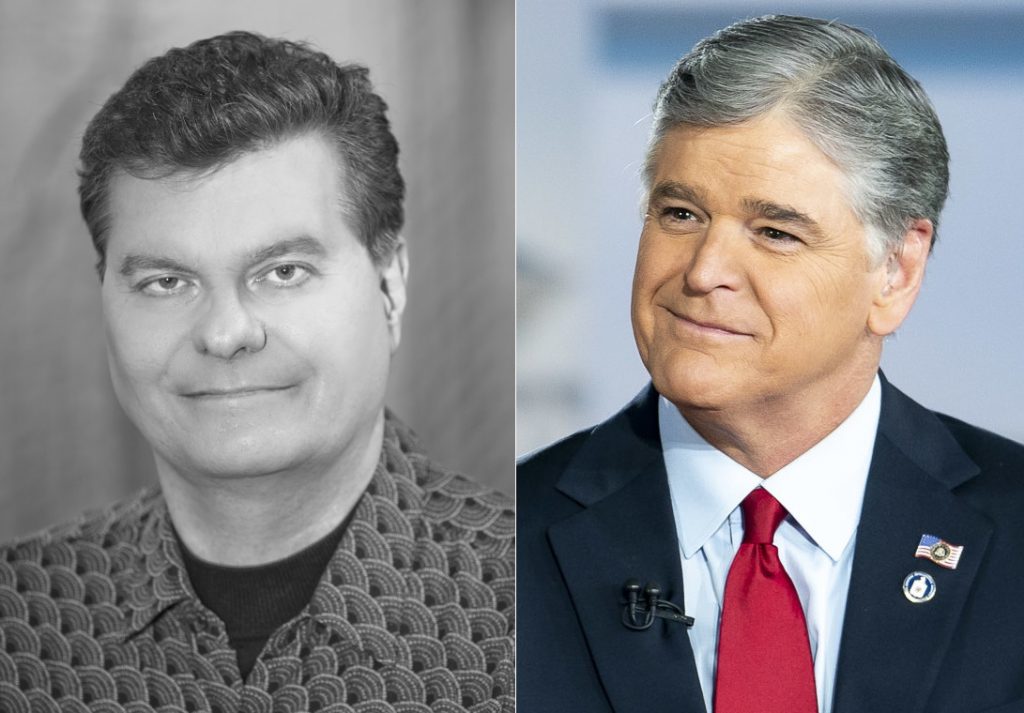How Talk Radio Took Over Wisconsin
Most news and talk stations in state are dominated by right-wing voices.

Mark Belling and Sean Hannity. Belling photo from Belling.com, Hannity photo from The White House (2020).
When discussions arise about the causes of the increasing partisan divide in the U.S., some point to Fox News, social media and other causes. But what rarely gets mentioned is the loss of the “fairness doctrine” and the resulting explosion in one-sided conservative talk radio, which transformed states like Wisconsin.
The fairness doctrine was rooted in the Radio Act of 1927, which mandated that radio stations serve the public interest. By 1949 the Federal Communications Commission required “a basic standard of fairness” in broadcasting and giving candidates running for office equal time. Conservative Phyllis Schlafly was a major proponent of the doctrine, and used it to gain media coverage for her Anti-Equal Rights Amendment campaign in the 1970s.
But in 1987, under President Ronald Reagan, the FCC formally repealed the fairness doctrine and within a year Rush Limbaugh, who’d had a checkered career until then, gained national syndication for his right-wing talk show. Mark Belling arose around the same time first with a Madison radio talk show and beginning at WISN in Milwaukee with an afternoon talk show in March 1989. Later that year Charlie Sykes started working as a substitute for Belling, got his own show on WISN by 1992 and then jumped to WTMJ in 1993 with a morning show.
Few big cities in the country had two conservative talk radio stations that were so dominant, but the entire state was eventually blanketed, as a new book about Wisconsin, Battleground, documents. By 2016 there were 77 radio stations in the state running a total of 223 hours per week of talk radio commentary, the book’s researchers found.
Battleground was written by six academics, including five UW-Madison professors, not to track talk radio, but to study “the Erosion of Civil Society in Wisconsin.”
“We started the project ten years ago, in 2012, right after the Act 10 explosion in Wisconsin,” notes co-author Lewis Friedland, who has since retired as a UW-Madison professor, but is still involved in the ongoing research project. “It is the most complete longitudinal study of a state’s political communication that exists.”
In trying to understand what changed Wisconsin, the book found three trends that created “a radicalization cycle,” Friedland explains. First, the major cultural shift as rural whites, mostly older people, shifting allegiance to the Republican Party. Second, “the drying up of local news environments as newspapers got thinner and thinner with largely no coverage of local legislators.” And third, how that void was filled by talk radio, which “is perfect for rural areas,” he adds, “where people are often driving long distances and listening to the radio.”
The first factor was previously discussed by one of Battleground’s co-authors, Prof. Katherine Cramer, whose 2016 book, The Politics of Resentment, has gotten considerable coverage. But the impact of talk radio may be just as powerful.
Many stations in the state carried the syndicated shows of Limbaugh and Sean Hannity, which accounted for 75 hours per week on conservative talk radio stations in the state as of 2016. The death of Limbaugh has somewhat reduced those numbers, as other less-popular syndicated conservative talkers replaced Limbaugh. As of 2020, Friedland and his researchers estimate, there were 53 stations in the state running 151 hours per week of conservative commentary.
They estimate that conservative talk radio accounted for 61% of all talk/news programming from 8 a.m. to midnight in the state in 2020 and reached 5.6 million of 5.8 million state residents.
Conservative talk radio, says Friedland, is “the electricity that keeps that radicalization cycle going” in Wisconsin.
“It’s no accident that Ron Johnson spent so much time on conservative talk radio in the 2022 election campaign.”
By late October of the 2022 election campaign, Wisconsin’s incumbent U.S. Senator had made at least 325 appearances on talk radio shows, including 186 in Wisconsin, the New York Times reported. Listening to all of Johnson’s appearances “would take more than four full days,” the story noted
As local news coverage has declined in the past 20 years the conservative talk radio that filled the void was mostly nationally syndicated programming. The top 15 right-wing talk shows are putting out around 45 hours of content every day, as Paul Matzko, author of a book on talk radio, has estimated.
“I think talk radio helped nationalize politics before Fox News came around,” Friedman says. “Fox built on top of that.”
Fox News began broadcasting in 1996, eight years after Limbaugh’s show was syndicated.
That said, not everyone listening to talk radio necessarily agrees with all the views espoused. Battleground devotes a chapter each to three key issues — health care, immigration and Foxconn — and finds much disagreement with the Republican view on the latter two issues. Rural Wisconsin’s dairy farmers, after all, are heavily dependent on Mexican immigrant labor. And Foxconn, even before it became clear little development was going to occur, was seen by many as having no benefits for residents outside southeast Wisconsin.
Still, there is a tight relationship between talk radio and the Republican party. Prior to becoming a WTMJ talk show host Jeff Wagner was a Republican candidate for Wisconsin Attorney General. Then-legislator Scott Walker was a frequent guest on the TV pundit shows of Belling and Sykes, and both promoted his campaigns for Milwaukee County Executive and governor. Conservative Milwaukee Sheriff David Clarke was a substitute host for Belling at times. And longtime Republican official and current state party chair Brian Schimming held a job as a talk show host for News/Talk 1310 WIBA in Madison for some time.
Progressive radio station owner Michael Crute has often checked out the conservative competition and says that in driving across the state in the past year “I’ve often heard Schimming filling in for the host on a number of stations.”
As Battleground describes it, conservative talk radio “ties voters to the Republican Party on both national and state issues by providing… a constant stream of partisan political content.”
Murphy's Law
-
The Last Paycheck of Don Smiley
 Dec 17th, 2025 by Bruce Murphy
Dec 17th, 2025 by Bruce Murphy
-
Top Health Care Exec Paid $25.7 Million
 Dec 16th, 2025 by Bruce Murphy
Dec 16th, 2025 by Bruce Murphy
-
Milwaukee Mayor’s Power in Decline?
 Dec 10th, 2025 by Bruce Murphy
Dec 10th, 2025 by Bruce Murphy






















Good overview, Bruce. The last piece of the puzzle has to do with the corporate radio bosses who thought that saturating this RW poison over the airwaves was a good business model. And in whether the hosts were pushing the politicians, or if the politicians and their donor puppetmasters were telling the hosts what to say.
Either way, RW hate radio (and the rubes that bought their BS) has a lot to do with the anger and resentment that has hurt what used to be a great state with a high quality of life.
The end of the “fairness doctrine” was a disaster for public discourse. We’re left with Sinclair and other near monopolies commanding the for-profit airwaves and an increasingly corporate “public radio”. Long live community radio!
Good report. Did the death of the Fairness Doctrine usher in propaganda radio? There still people who believe all news or talk shows present balanced reporting. In advertising, I once read a person must hear a message 14 times to get the message. Certainly the constant drum beat on talk radio shows gets a person to hear the message, truthful or not.
Are there any legislators today willing to step forward to reinstate the fairness doctrine to restore faith in government and to stop the division tearing the country apart?
High listenership ratings spawns advertising revenue which all these outlets enjoy.
A responsible reaction is to boycott the advertisers.
Yes, little can match the severe head trauma caused to listeners by prolonged exposure to right wing hate radio. (Just looking into that photo of Belling’s dead eyes causes me some emotional distress). But lets not forget the everyday head trauma we are all exposed to thru non locally owned corporate media and their never ending coverage of the “news”. We have the Telecommunucations Act of 1996 to thank for that.